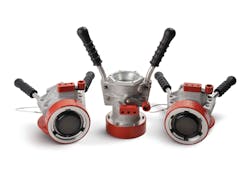Lightweight Nozzles Made For Heavy-Duty Work
Consider a day in the life of a commercial aircraft fueler. Working in all kinds of weather with a naturally hazardous commodity. Operating a refueling truck, pulling out as much as 50-feet of heavy 4-inch hose, then lifting as much as 60 pounds above their heads all while standing on a ladder to couple the nozzle to the under-wing fueling port.
Once that's done, they must climb back up the ladder and remove the nozzle. How many trips up and down that ladder? One trade group gives the average as 25 trips in and out of that truck reaching fill point 12 feet off the ground. Heck, wouldn't you just be more than a little tempted to just drop the thing to the ground and happily drag it along the ramp?
So if a nozzle comes out that takes a bit of the weight off the fuelers' arms and shoulders and that's still rough-and-tough, that would be a welcomed addition to a ground support crew's arsenal.
We saw one such new nozzle series, the F145 pressure refueling nozzles, introduced by Meggitt Control Systems at its booth at the inter airport Europe in Munich last October.
We talked with Mike LaPointe, director of marketing and Damon Thompson, manager of marketing & product support for Meggitt Fueling Products who gave us a run-down of the nozzle's features and benefits. Here are a few highlights of our conversation:
LIGHTER, BUT TOUGH
"The F145 is smaller and lighter," LaPointe said. The net weight of the basic nozzle weighs in at just over 6 pounds. "Health and safety department at some fueling companies believe this is a benefit for the workers."
However, the operating lever is fully protected by a sacrificial wear block that withstands the common dropping and dragging of this equipment. (The red components you see in the product photo are those sacrificial parts that are easily replaceable by removing a single bolt.) The sacrificial material acts as a shock absorber against the dropping and dragging of the nozzle.
"We have had some of these nozzles in field trials for more than two years fueling thousands of different aircraft types and hundreds of thousands of gallons of jet fuel being pumped through them and they have never been repaired or replaced during that time," LaPointe added. "The ones that have come back for evaluation only needed some of the sacrificial material replaced before we send them out again to other customers to field trial for us."
INDEPENTLY TESTED
The recently updated SAE AS5877 spec dictates the requirements for all manufacturers various types of nozzles used for refueling aircraft fitted with pressure fuel servicing systems. This spec is for all nozzles that are used either in commercial or military applications. The nozzles must be compatible with and mate with the international adapter fitting in accordance to ISO 45 Aircraft Pressure Refueling Connections.
All this is par for the course for all providers of such products, however, LaPointe proudly pointed out that the company went the extra mile to meet the spec – and that distance didn't come cheap.
"We are the only company that had the complete testing done by an outside aerospace-accredited test lab," he explained. "The testing took more than seven months to complete and cost more than $300,000 to do."
3- OR 6-SLOT
The 145 series comes in both choices. The U.S. market grew up with 3-slot nozzle. Meanwhile, the European and Asian market always have had and preferred the 6-slot nozzle. Regardless of the number of slots, however, all nozzles have to mate with the standard 3-lug international aircraft adapter.
"The 6-slot nozzle is easier to connect as it takes less movement of the nozzle to locate the mating three lugs on the aircraft adapter to connect it to," Thompson said.
How easier? "We think the U.S. market will want the 6-slot once everyone realizes the ergonomics that differentiate the two types," Thompson explained. "With the 3-slot, a fueler needs to rotate the nozzle about 120 degrees; with the six-slot, the needed turn goes down to a much simpler 60 degrees."
CROSS UTILIZATION
The new F145 series was purposefully designed to use all the same accessories that are currently available on the company's F116/117 series nozzles. As a result, the 145 series can be configured to meet most any application in the field.
"Any time you can offer such interchangeability," Thompson explained, "that cuts back on parts, inventory and that all that saves companies a lot of money."
"We are currently starting official six-month field trials with the international oil companies in a few weeks," LaPointe reported to us a few weeks after we met in Munich. "Once that is completed we will have the approvals from those oil companies as well as the rest of the world."
In the meantime, LaPointe added that he's heard "nothing but praise from all fueling companies that have tried them, and have been informed by them of their intention on changing over to the new nozzle when they order new trucks or just replacement nozzles in the future."
About The Company: Meggitt has been a signature suppler of fluid control devices and systems for commercial and military aircraft, and numerous industrial applications since its formation in 1942. The company entered the aviation fuelling industry, however, only since 1993 when it acquired Thiem Industries and, later, Whittaker Controls in 1999. Its products include fuelling nozzles, bottom loading products, hydrant couplers and control valves and a line of under-wing nozzles covering equipment for the world's largest commercial airports and small community facilities.
In August 2005, Meggitt PLC acquired UK-based Avery-Hardly. Its fuelling capabilities were merged with those of sister Meggitt group company Whittaker Controls in California and, under the management of Whittaker Controls, became Meggitt Fuelling Products.
